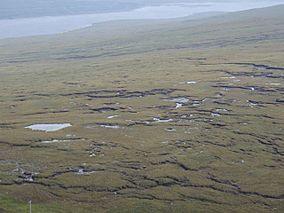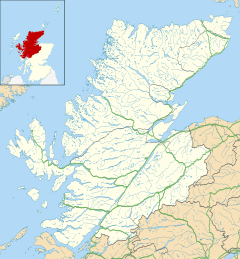Caithness and Sutherland Peatlands facts for kids
Quick facts for kids Caithness and Sutherland Peatlands |
|
|---|---|

A view of peatlands to the west of Loch Shin.
|
|
| Location | Highland, Scotland |
| Area | 1,453 km2 (561 sq mi) |
| Established | 1999 |
| Governing body | NatureScot |
The Caithness and Sutherland Peatlands is a huge natural area in the very north of Scotland. It's made up of many connected parts across the historic regions of Caithness and Sutherland. This special place is known as the Flow Country.
It covers a massive 143,503 hectares. That makes it one of the biggest protected nature sites in the whole United Kingdom. It's also the largest Ramsar Site in Scotland.
This area is home to many different plants. It also supports a wide range of waterfowl (birds that live near water). These include important groups of greylag goose and dunlin. You can also find rare kinds of moss here.
The Caithness and Sutherland Peatlands are recognized as a wetland of international importance. This means it's super important for nature around the world. It has also been given special protection names like Site of Special Scientific Interest, Special Protection Area, and Special Area of Conservation. A part of it, about 154 square kilometers, is even a national nature reserve called Forsinard Flows.
Contents
What are Peatlands and Blanket Bogs?
The Caithness and Sutherland Peatlands are mostly made of something called blanket bog and peatland. Imagine a huge, squishy sponge covering the land!
What is Peat?
Peat is a type of soil that forms over thousands of years. It's made from dead plants that don't fully rot away. This happens because the ground is very wet and doesn't have much oxygen.
Think of it like this: when plants die in a normal forest, they break down quickly. But in a bog, the water stops them from rotting completely. Over time, these squashed, half-rotted plants build up layer by layer. This creates a thick, dark, spongy material called peat.
What is a Blanket Bog?
A blanket bog is a special kind of peatland. It's called a "blanket" bog because the peat covers the land like a blanket. It doesn't just fill hollows or valleys. Instead, it spreads over hills and slopes, creating a vast, flat, and often wet landscape.
The Caithness and Sutherland Peatlands are one of the best examples of blanket bog in the world. This makes them incredibly important for nature.
Amazing Animals and Plants
The Caithness and Sutherland Peatlands are a fantastic home for many different creatures and plants. The wet, boggy environment creates a unique habitat.
Birds of the Bogs
This area is especially important for birds that love wetlands. Many different kinds of waterfowl come here to breed. Some of the most important birds you might see include:
- Greylag Geese: These large, grey geese are a common sight. They nest and raise their young in the quiet, open spaces of the peatlands.
- Dunlin: These are small, busy shorebirds with long beaks. They love to feed in the wet, muddy areas of the bog.
- Golden Plover: These beautiful birds have a striking golden-spotted back. Their calls are a classic sound of the Flow Country.
- Greenshank: These elegant wading birds have long, greenish legs. They are quite shy but can be spotted near pools and streams.
- Red-throated Diver: These sleek diving birds are often seen on the many small lochs (lakes) within the peatlands.
Many other bird species also rely on this habitat. It's a vital nursery for young birds.
Unique Plants and Mosses
The plants here are specially adapted to live in wet, nutrient-poor conditions. You'll find:
- Sphagnum Moss: This is the most important plant in a bog. It's a special kind of moss that can hold huge amounts of water. It helps to create the wet, acidic conditions that form peat.
- Carnivorous Plants: Look closely and you might spot plants that eat insects! These include sundews and butterworts. They catch insects to get nutrients that are missing from the boggy soil.
- Cotton Grass: In summer, the bogs are dotted with fluffy white tufts of cotton grass. It looks like snow, even on a warm day!
- Heather and Cross-leaved Heath: These tough, small shrubs add colour to the landscape, especially when they bloom.
Some of the mosses found here are very rare. They are found in only a few places in the world.
Why is This Area Special?
The Caithness and Sutherland Peatlands are protected for many important reasons. They are not just a home for wildlife; they also play a big role in our planet's health.
A Global Treasure
The area is recognized as a wetland of international importance under the Ramsar Convention. This is an international agreement that helps protect important wetlands around the world. Being a Ramsar Site means it's considered vital for global biodiversity.
Special Protections
Because it's so important, the peatlands have several special protection titles:
- Site of Special Scientific Interest (SSSI): This means the area is important for its plants, animals, or geology.
- Special Protection Area (SPA): This protects the area for its birds, especially those that are rare or endangered.
- Special Area of Conservation (SAC): This protects the area for its habitats and other species, like rare plants.
- National Nature Reserve (NNR): A part of the peatlands, called Forsinard Flows, is an NNR. These are places where nature is the top priority, and they are managed to help wildlife thrive.
Fighting Climate Change
Peatlands are amazing at storing carbon. When plants die and form peat, the carbon they absorbed from the air gets locked away in the ground. This helps to reduce the amount of carbon dioxide in the atmosphere, which is good for fighting climate change. The Caithness and Sutherland Peatlands hold a huge amount of carbon, making them a natural "carbon sink."
A Place to Explore
While it's a wild place, parts of the Caithness and Sutherland Peatlands are open for visitors. There are special boardwalks and trails at places like the Forsinard Flows National Nature Reserve. These allow you to explore the unique landscape without disturbing the fragile environment. It's a great place to learn about nature and see rare wildlife up close.


